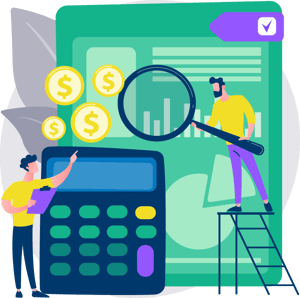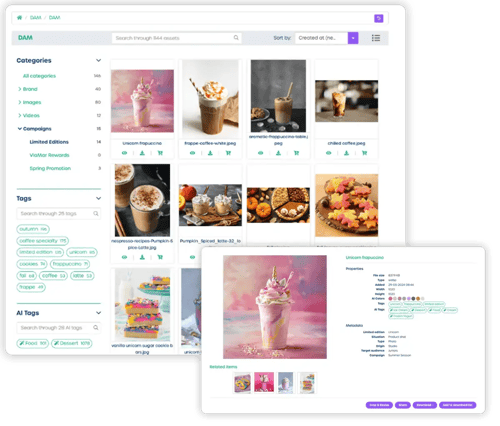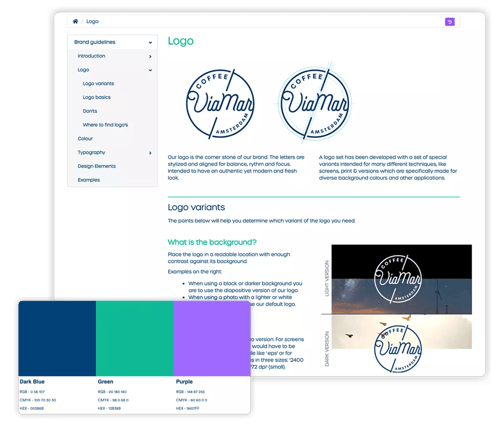Marketing Resource Management 101
Last updated: October 3, 2025
Does running your marketing department feel like taming a multi-headed beast? Have you been finding it hard to shift budget, people, focus, and marketing materials consistently and flexibly? If your answer to these two questions is in the affirmative, then you need to give an approach called marketing resource management (MRM) a proper thought.
As marketers, we know the importance of brand management to help build and nurture closer relationships with our customers. We also understand how important it is to maintain a consistent, high-value brand across various online and offline customer touchpoints. But what most marketers don't know is that marketing resource management is an indispensable part of brand management. The two concepts are, quite frankly, inseparable.
Today's article helps you make sense of marketing resource management and its importance to your overarching brand strategy.
What is Marketing Resource Management (MRM)?
Marketing resource management (MRM) sounds like a phenomenon reserved for mega-corporations.
In reality, though, MRM is a way of unifying marketing collateral like an online style guide and digital assets under one simple solution.
MRM is conceptually similar to ERP (enterprise resource management) in that it takes a centralized approach to resources, gathering them in a single ecosystem that's accessible to everyone. The idea is that productivity will increase when marketing teams aren't constantly starting from scratch.
As marketing departments become more and more complex, MRM software is becoming a must-have tool for many marketing managers. Which begs the question: what's MRM software?
Marketing resource management software is simply a solution that can help large and small marketing teams accomplish more in less time. Put differently, MRM software is designed to assist teams in solving all of the aforementioned marketing problems—from strategic planning to collaboration to brand asset management.
Crucially, MRM solutions support integrations with existing marketing technologies (MarTech), helping bring together different marketing initiatives, data, processes, and resources into a central, all-powerful workflow. Not only can this help harmonize fragmented processes and keep everything in seamless coordination, but it also simplifies marketers' work.
Why Marketing Resource Management is Important
Not having a marketing resource management solution means your team is wasting time and, therefore, not being as productive. That cuts directly into the bottom line.
Creative teams know the pain of being bombarded with requests from product, sales, and other teams every time they need a company logo or a tweak to an existing image. Just think of how much time can be saved without all the incessant back and forth.
MRM software creates efficiencies and puts an end to the grunt work that weighs down busy teams. And, when marketing assets and initiatives are easily accessible from a single, centralized ecosystem, marketing teams can have a more streamlined user experience.
More specifically, marketing resource management solutions' main benefits include:
1. Save Time
Did you know that employees spend at least 25% of their workweek looking for the documents and information they need to do their jobs?
In today's fast-moving, ever-evolving marketing environment, time really is money. Every minute you save is invaluable to your bottom line.
Marketing resource management provides your teams with automation and workflows to help you get projects across the line faster while still maintaining top-notch quality.
Replace your back-and-forth email threads and lengthy Slack conversations with a single source of truth where you can collaborate in real-time. Create, publish, and distribute content and marketing assets at scale with a centralized hub.
2. Stretch Your Budget
Stop wasting time and money recreating marketing assets and duplicating work. A marketing resource management software helps you do more with less.
It'll give you a platform to consolidate your budget, ideas, resources, and marketing plans. See exactly where you're allocating your dollars and what you need to tweak to ensure campaigns get completed in full and on time.
Notice an important project falling behind? An MRM solution lets you borrow from a low-priority campaign to ensure it stays on track.

3. Stay on Top of Your Projects
Most marketing managers don't think of themselves as project managers, but that's a misplaced notion. Aside from your everyday marketing responsibilities, you're also responsible for developing detailed project plans, coordinating internal resources, and, more importantly, monitoring the progress of all your campaigns.
Thankfully, this is one of the most significant benefits of MRM. An MRM solution will give you a firm grasp on your team's workload and progress—at any given moment. This allows you to delegate, assign, and re-assign tasks and projects so that you can manage your team's work schedule more effectively. This means more unnecessary meetings, endless chat threads, and lost emails.
4. Supercharge Your Creative Workflow
Producing exceptional content consistently and on time takes monumental effort. Typically, several people are involved in editing, approving, and mocking up, and without a sustainable workflow, there's bound to be chaos somewhere down the line.
Does the lack of a clear approval process cause bottlenecks for your team and slow down time-to-market? MRM can solve this by creating a central hub where everyone knows who is responsible for what and where the project is within its lifecycle. The best part about all this is that you no longer have to endlessly chase down approvals.
5. Protect Your Brand
As we mentioned earlier, MRM and brand management are two inseparable concepts. Perhaps what's worth noting about them is that they're not a one-and-done part of your business.
You have to work hard to ensure the messaging, taglines, voice, colors, and assets stay consistent with your brand guidelines.
The best MRM software systems give you complete control of your brand with compliance workflows, usage history, and version control. Ensure only the right content gets shipped and old branding gets locked away for inspirational and historical purposes.
6. Track Assets Effectively
Chances are, you spend way more time than necessary trying to track down an image or logo. Even with your entire marketing department using Office 365 or Dropbox, it can be challenging to figure out where each asset is located.
Thankfully, most MRMs have built-in Digital Asset Management (DAM) functionalities. DAM components can centralize your organization's digital assets, which eliminates the need to spend hours tracking down images, header graphics, logos, and the likes.
7. Explore New Possibilities
With more time and budget, you'll be empowered to test new marketing use cases with more confidence. You won't be fighting a monthly or weekly battle of getting campaigns across the finish line. Instead, you'll be completing marketing initiatives with newfound efficiency and a relentless hunger to surpass expectations—every single time.
Marketing Resource Management Solutions
MRM is more than centralizing digital assets and making them readily available to your teams. There are different solutions, processes, and principles involved, all of which play to the overall goal of making marketing as efficient and effective as it can be.
Here are the fundamental building blocks of a modern MRM approach.
1. DAM Solution
To put it frankly: without a digital asset management solution, the whole MRM approach is pretty much nonexistent.
DAM solution is the media library MRM is built upon. Not only does it store a company's digital assets, it also filters, indexes, and organizes them for easy and on-demand access.
So, whether your team is working on a lead generation campaign, product marketing campaign, or something a little more complex, DAM software can centralize all the information and resources you need to ace that campaign.
However, advanced DAM solutions allow you to do a lot more. Marvia's DAM, for instance, lets you preview all of your files before hitting the send button. On top of that, you can share content quickly and securely straight from your DAM via transfer links, custom collections, or channels. And if you need to add expiration dates, publication rights, and watermarks to your exclusive content, Marvia has that capability, too!

2. Brand Guidelines
If DAM is the foundation on which the MRM structure rests, brand guidelines are the poles holding the structure in place.
A brand style guide helps ensure your MRM strategy correctly applies your brand identity (think: typography, colors, and logos). Put differently; it standardizes how your brand is perceived across all media and distribution channels. These are the pillars of a strong and consistent brand experience.
Marvia's brand guidelines software helps you share your brand manuals internally and externally. Referring directly to essential brand assets that are located in the DAM such as fonts and logos never has to be a hassle.

3. Distributed Marketing Solution
This solution comes in handy when you want to adapt and localize content. It's beneficial for regional or franchise companies as it allows the creation of templates and definite rules for typography, colors, logo positioning, and the general appearance of marketing materials.
Within the MRM ecosystem, these templates are accessible and can be changed by any authorized person. This has one huge benefit—it allows you to create powerful, cutting-edge marketing campaigns at all levels, from international to local, to ensure brand coherency and identity.
Marvia's all-in-1 distributed marketing platform was designed with the MRM approach in mind. Above all else, it enables marketers like you to achieve: branded content for all channels in minutes, campaigns distributed across channels quickly and confidently, and provides partners the tools to capitalize on local marketing insights.
4. Centralized Workflows
You won't be able to efficiently validate your content if you are missing one of the internal or external workflows. Both are pertinent to the MRM approach. By bringing them together under the same roof, it gets easier to keep track of each project, streamline content creation processes, and efficiently organize the work of each project participant.
Marvia's brand management portal lets teams ensure brand consistency while enabling local sales, marketing, and partners to create centralized workflows for specific asset types, projects, and markets.
Invest in MRM for Better Campaigns
There are no hard and fast rules for mastering the MRM approach. However, it should ideally be hinged on a robust MRM software solution. You'll want to make sure that you're investing in a platform that's as multifaceted as it is versatile and functional. But above all, remember that an MRM is the future, and the future is now.
Ready to change the way you approach marketing resource management? Get started with Marvia's brand management portal.
